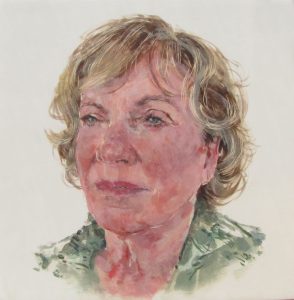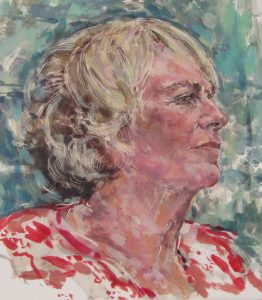
Herstory: Kathy Chambers
Interview 28 June 2010 Helensburgh
Present: Kathy Chambers, Frances Robertson and Sharon Thomas
Kathy Chambers was the Exhibitions Coordinator at Glasgow School of Art from 1990. The exhibitions programme in the Art School is not only a visual resource and inspiration to all the students at the school, but has also given training and financial support to many students (including Sharon Thomas) who have found work as exhibition assistants. The programme has allowed students to gain knowledge of the processes of hanging and organizing art shows, as well as being employed to invigilate exhibitions and assist at opening nights. Kathy is now retired and is in the process of moving to France with her husband, more or less permanently, although she retains a base and many family connections around Scotland. During the period of our interview and portrait sitting, Kathy was staying n Helensburgh, a coastal town on the river Clyde west of Glasgow where the enclosed river gives way to the picturesque jumble of mountains and sea lochs of the Firth of Clyde. Sharon and I traveled out to this visit on the suburban train that connects Helensburgh to Glasgow along the line of the river, and in the pleasant summer weather of June our journey had an excursion-like quality. As Kathy is retired, and because Sharon had such good memories of working with her in the exhibitions programme, this particular interview had a warm reflective quality. In addition, Kathy had her own personal story to tell, reaching further back to the times when she herself was a student at Glasgow School of Art.

Kathy Chambers egg tempera sketch, 2010
Kathy’s career as a student was broken up in a fairly typical way for a woman of this period, as she got married and then left at the end of third year when she was pregnant in -. She looked after her family, often living abroad while her husband (a painter and educator) pursued his career in art schools outside the UK. She returned to full-time study in 1980 when her children were grown up and studied sculpture. She had to start again at the beginning because the degree programme had been introduced since the first time she had been a student. It was tough in some ways being older, and often difficult to pay the fees. Although the advantage was that she was no longer felt shy and clueless, instead she realized she had a strong urge to compete and show what she could do. Her women friends were supportive, both emotionally and also occasionally financially, when she had to borrow some money to cover the fees. She remembers however that in this era of ‘female solidarity’ all her friends had a clear sense that she deserved support not just individually, but also politically because she was ‘flying the flag for women’.
Kathy recalled that the first time she went to college in the 1960s, women were definitely treated differently from now, when it was looked on very much as a ‘finishing school’ for middle-class girls. The second time she went to college, she was informed personally and politically by contact with the women’s movement is one aspect of women’s self-knowledge she feels has waned since then, and she laments the apparent sexualization and self-objectification that young women seem to have taken on today. I asked Kathy if she had any particular favourite portrait painters whose work she enjoyed, and why. I mentioned Holbein as one of my own choices, and Kathy agreed she liked him too on account of his draughtsmanship and the way he reminded us of what people looked like. But overall, she would always choose Rembrandt as king of portrait painters for his humanity. Other favourites included Ingres and Picasso, then David Hockney, whose painting of Celia and Ossie she noted had had a striking impact when she was a young student.
After graduating, Kathy worked for a while as in ‘community arts’, running classes and activities in Govan mainly for people over 50. Many students were ex-shipyard workers, with a fund of stories, reminiscences and opinions. Some of the work produced in these projects included a clay relief cast in concrete of notable buildings and sites in Govan, and also a complete replica of a ‘single-end’ apartment built and then furnished by the group through negotiations and reminiscence. The installation was exhibited in the Pearce institute in Govan, and the concrete relief in the Newbery Gallery at GSA. Other work from the 1990s include the bronze Topographical Relief Maps that are well-known landmarks in Glasgow for example in Buchanan Street at the junction with St. Vincent St (1990) and at Kelvingrove Art Galleries (1996). These projects and the exhibitions meant that Kathy’s professional practice and ideas became known in GSA, which helped when she competed for the post of Exhibitions Coordinator.
The exhibitions programme at GSA in those days was driven by the ideas and inspiration of a committee of artists, designers and academics from all parts of the school. Some of the highlights she recalls from this creative and collaborative planning process were exhibitions such as 2001 the year of Japanese culture with an exhibition of manga comics that benefited from the work of Juliet Kinchin in the archives and finding such unfamiliar images as Japanese prints of boats built in Glasgow for the Japanese navy and given as gifts to Glasgow.
Women artists and feminist ideas from Glasgow that have made in impression on Kathy include work such as that of Jenny Saville, but also exhibitions such as Jude Birkhauser’s ‘Glasgow Girls’ exhibition and publication (this theme has recently been reinvigorated by a new Glasgow Girls exhibition at GSA curated by Liz Arthur in 2010). The Glasgow School of Art was originally set up in 1845 at the Government School of Design, and the Design School is still a major part of its output and culture. Hence the exhibitions at GSA have included not only the more male-dominated high arts such as painting or sculpture, but also other decorative arts that have had more female input such as textile design and making, so the GSA has hosted major exhibitions on the textile designer Lucienne Day, and also an exhibition of Chinese MIAO Costume. Indeed, the show that Kathy felt most proud of during her time as Exhibitions Coordinator was the Kathleen Mann exhibition, that she herself researched and organized. Kathleen Mann was an important figure in the first half of the twentieth century because of her embrace of technology in her understanding of textile design and production and move away from a more ladylike model of studio practice. Unfortunately, Mann’s own career as a teacher was cut short when she married due to the so-called marriage bar on women’s employment in teaching. Kathy recalls even in her own childhood how this bar resulted in a vast body of spinster teachers at all levels from kindergarten to higher education, a group that has now almost vanished from consciousness. Kathy recalled the unkind epigram invented by the mother of one of her friends that sums up the scornful derision once routinely given to women put into this unenviable position by legislation, not personal choice:
Soor faces
Attaché cases
Big bunches o’ flooers
Now there are more women in art, and as noted, Kathy’s two careers as an undergraduate at GSA decades apart allowed her to se just how much more at ease women students are with a professional working idea of what they are doing, rather than as a kind of fun thing to do before getting married (as earlier). Nevertheless, there are still less ‘stars’ in the art world who are women, especially in comparison to the proportionally larger percentage of women over men who enter the Art school, but there are many support workers, curators and gallerists who are women, perhaps because these roles, Kathy suggests, require tact, negotiation and team work. Finally, though, when we asked Kathy if she had a particular heroine, she found this quite hard to answer in relation to visual artists, finding writers and poets more inspiring.
Finally, after some thought, she nominated Louise Bourgeois as not only inspiring, unexpected but also because she has been so durable, negotiating the wastage of youth in a remarkable way.
Frances Robertson, 2010
Copyright Frances Robertson
